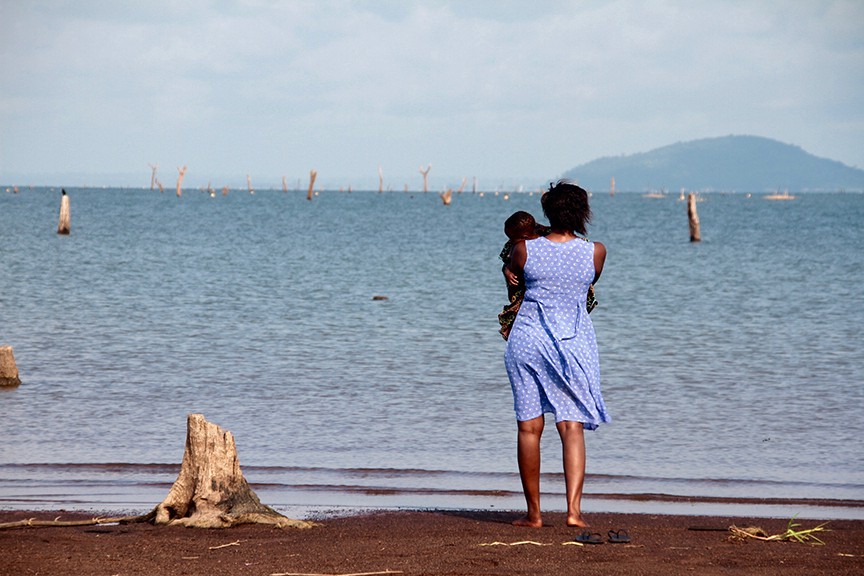Priscilla Anany was born in Ghana and migrated to the U.S. She studied Fine Arts at the University of North Carolina’s School of Arts’ School of Filmmaking and obtained her Master’s degree in Communications from New York University. Anany is an advocate of women’s empowerment and likes to tell stories about women and their strengths. (Press materials)
“Children of the Mountain” will premiere at the 2016 Tribeca Film Festival on April 17.
W&H: Describe the film for us in your own words.
PA: “Children of the Mountain” is a story about a woman who gives birth to a deformed and sickly child. Because she’s criticized and blamed for her child’s conditions, she becomes determined to do everything in her power to find a cure for him. When all fails and she becomes hopeless, she’s pushed to getting rid of her child.
W&H: What drew you to this story?
PA: I had an aunt who died when she was very young and my mother told me stories about how their parents struggled to find a cure for her. They tried various hospital, traditional healers, witch doctors, shamans, the church for miracles and pretty much just anybody who claimed they could cure her. That was my first inspiration — to write a story about a mother who will do anything for her child’s health.
I also wanted to combine that with prose a friend of mine had written, which expressed her rationale for why her daughter was born with Down Syndrome. She felt it might have been her fault.
W&H: What do you want people to think about when they are leaving the theater?
PA: Every now and then we hear stories in the news about how someone killed or harmed their special needs child. I want my audience to somehow get a glimpse of understanding as to how people are pushed to make such wrong choices.
In fact, the real mother of the cleft palate child we worked with in the film confessed that she had felt the edge to somehow get rid of the child at some point. And by the way, cleft palate is a condition that can easily be fixed, but in certain developing areas, it’s not as easy — health doesn’t come easy. So such a condition is a big deal for people in those areas.
W&H: What was the biggest challenge in making the film?
PA: Finding Jessica, [the child actress in the film,] was the most challenging. To establish the realism of the film and to have it as realistic as possible, I wanted to have a child with the real-life conditions projected in the story.
Besides, this was a low-budget indie and I knew I wouldn’t be able to afford CGI. Fortunately, we found the Graft Foundation, which is a Ghanaian-based and funded foundation that offers free surgeries to deformed children not just in Ghana, but in neighbouring West African countries. Once they read the script, they were willing to assist. They had a list of kids who were awaiting surgeries but then the next challenge was to find a family that would agree to have us work with their child.
Prior to finding the Graft Foundation, we had gone to a couple of hospitals and had found some kids with cleft lips, but their families were uncomfortable with us featuring them in a films. Many were ashamed of the condition. Fortunately, Jessica’s parents were willing to allow me to work with Jessica.
W&H: How did you get your film funded? Share some insights into how you got the film made.
PA: My mother had just sold her house and I begged her to give me some of the money to make my film. She couldn’t say no because she had seen how I had been struggling to fund the project.
I tried a small scale crowdsourcing campaign by reaching out to very specific people, friends and families and asking them to donate. I did get some help from a few people.
Finally, I got some grants from the Jerome Foundation and the Women in Film Finishing Fund. I’m very grateful to these foundations.
W&H: What’s the best and worst advice you’ve received?
PA: The worst advice I’ve received is “Forget this difficult film industry and go get a Master’s degree in a different industry where you can be sure to get a job and earn a living,” which I did. I went for a Master’s degree in Corporate Communications and Public Relations, and two years later, I still haven’t worked with the degree I obtained. I’m still pursuing film.
The best advice I’ve received was when I was struggling to raise funding for my film and I didn’t get some cinema funds I had applied for. I was so devastated and said I was going to quit. My best friend said to me: “It’s okay to quit today, but tomorrow you have to start trying again.” I took that advice as well.
W&H: What advice do you have for other female directors?
PA: I’d say they should keep going and keep trying hard to tell the best stories and making the best films despite the challenges they face.
W&H: Name your favorite woman-directed film and why.
PA: I really enjoyed the film “Girlhood” by director Céline Sciamma. I think for most girls it’s either their story or the opposite. For me, it was the opposite, which actually made me appreciate my mother, my family and the kind of home I had when I was going up. In terms of her film style, I think Sciamma uses less to achieve more, which is, to me, is more impactful.







